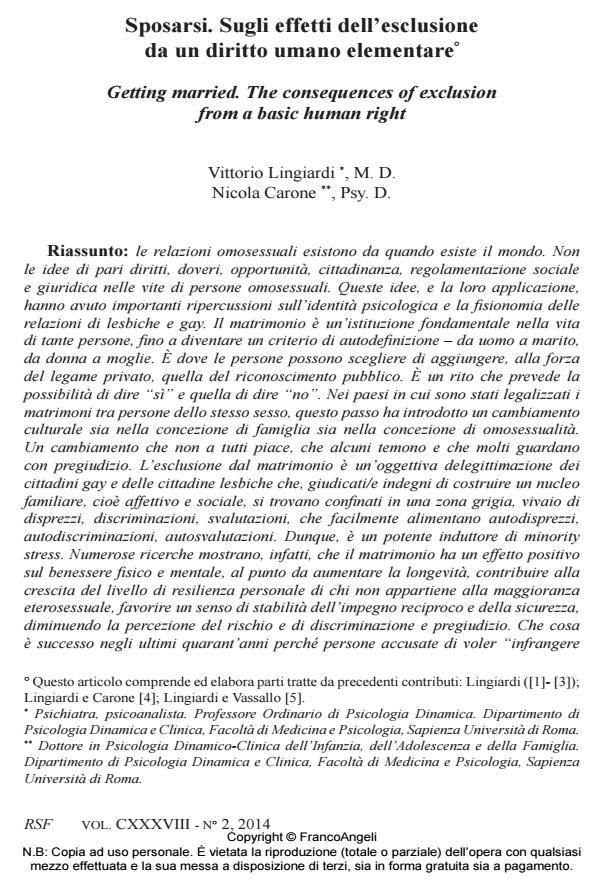Sposarsi. Sugli effetti dell’esclusione da un diritto umano elementare
Titolo Rivista RIVISTA SPERIMENTALE DI FRENIATRIA
Autori/Curatori Vittorio Lingiardi, Nicola Carone
Anno di pubblicazione 2014 Fascicolo 2014/2
Lingua Italiano Numero pagine 28 P. 85-112 Dimensione file 1660 KB
DOI 10.3280/RSF2014-002007
Il DOI è il codice a barre della proprietà intellettuale: per saperne di più
clicca qui
Qui sotto puoi vedere in anteprima la prima pagina di questo articolo.
Se questo articolo ti interessa, lo puoi acquistare (e scaricare in formato pdf) seguendo le facili indicazioni per acquistare il download credit. Acquista Download Credits per scaricare questo Articolo in formato PDF

FrancoAngeli è membro della Publishers International Linking Association, Inc (PILA)associazione indipendente e non profit per facilitare (attraverso i servizi tecnologici implementati da CrossRef.org) l’accesso degli studiosi ai contenuti digitali nelle pubblicazioni professionali e scientifiche
Le relazioni omosessuali esistono da quando esiste il mondo. Non le idee di pari diritti, doveri, opportunità, cittadinanza, regolamentazione sociale e giuridica nelle vite di persone omosessuali. Queste idee, e la loro applicazione, hanno avuto importanti ripercussioni sull’identità psicologica e la fisionomia delle relazioni di lesbiche e gay. Il matrimonio è un’istituzione fondamentale nella vita di tante persone, fino a diventare un criterio di autodefinizione - da uomo a marito, da donna a moglie. È dove le persone possono scegliere di aggiungere, alla forza del legame privato, quella del riconoscimento pubblico. È un rito che prevede la possibilità di dire "sì" e quella di dire "no". Nei paesi in cui sono stati legalizzati i matrimoni tra persone dello stesso sesso, questo passo ha introdotto un cambiamento culturale sia nella concezione di famiglia sia nella concezione di omosessualità. Un cambiamento che non a tutti piace, che alcuni temono e che molti guardano con pregiudizio. L’esclusione dal matrimonio è un’oggettiva delegittimazione dei cittadini gay e delle cittadine lesbiche che, giudicati/e indegni di costruire un nucleo familiare, cioè affettivo e sociale, si trovano confinati in una zona grigia, vivaio di disprezzi, discriminazioni, svalutazioni, che facilmente alimentano autodisprezzi, autodiscriminazioni, autosvalutazioni. Dunque, è un potente induttore di minority stress. Numerose ricerche mostrano, infatti, che il matrimonio ha un effetto positivo sul benessere fisico e mentale, al punto da aumentare la longevità, contribuire alla crescita del livello di resilienza personale di chi non appartiene alla maggioranza eterosessuale, favorire un senso di stabilità dell’impegno reciproco e della sicurezza, diminuendo la percezione del rischio e di discriminazione e pregiudizio. Che cosa è successo negli ultimi quarant’anni perché persone accusate di voler "infrangere quel modello nel quale si articolano la generazione, la differenza dei sessi e quella delle generazioni" arrivino a chiedere non solo di essere riconosciute come cittadini a tutti gli effetti, ma anche di poter adottare quell’"ordine familiare" che tanto ha contribuito alla loro delegittimazione?
Parole chiave:Matrimonio, omosessualità, omogenitorialità, diritti, minority stress, salute mentale.
Vittorio Lingiardi, Nicola Carone, Sposarsi. Sugli effetti dell’esclusione da un diritto umano elementare in "RIVISTA SPERIMENTALE DI FRENIATRIA" 2/2014, pp 85-112, DOI: 10.3280/RSF2014-002007